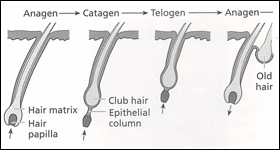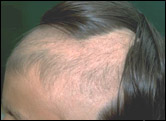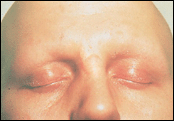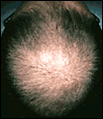Types of hair loss and different forms of Alopecia Areata disease
Hair Loss: Alopecia Areata
 A look at the causes and the only proven treatments for Alopecia areata, a condition characterized by patchy scalp hair loss. The name of a condition with several forms ranging from a single patch (Alopecia areata) to total body hair loss (Alopecia Universalis), the general form of Alopecia Areata has two typical types: Type one resulting in less than 50% hair loss, and type two resulting in more than 50% loss. A look at the causes and the only proven treatments for Alopecia areata, a condition characterized by patchy scalp hair loss. The name of a condition with several forms ranging from a single patch (Alopecia areata) to total body hair loss (Alopecia Universalis), the general form of Alopecia Areata has two typical types: Type one resulting in less than 50% hair loss, and type two resulting in more than 50% loss.
A sudden patchy loss of hair may be due to the condition known as Alopecia Areata. This condition is relatively common, and as many as 1 in 1,000 people may suffer from it at some time. The cause is unknown and occasionally it becomes very widespread and severe.
The causes can be numerous, but the good news is that it is many times due to an imbalance in the person's system, which if rectified, will result in complete regrowth of hair. An effective set of blood tests is necessary to reveal any imbalances. Some of the most common causes are medications, pregnancy, birth control pills, thyroid malfunctions, anemia, syphilis, and arthritis. Whatever the cause may be, the body's response is to initiate an autoimmune response, whereby the body perceives the follicles as foreign objects, and attempts to reject them from the system. A careful review of your medical history and the blood work we outline below should help identify the problem.
WWith Alopecia areata, usually, given time, the hair reappears on its own, although in persistent cases, steroid injections may help. Sometimes the condition becomes severe or recurrent, and the patient may even lose eyebrows and lashes (Alopecia Totalis) or all body hair (Alopecia Universalis). Overall, 50% of people experiencing AA before puberty will have more troubles with this condition throughout life.
TThere is no treatment which can provide a total cure for severe Alopecia Areata. A multifaceted approach has included the use of irritants such as dithranol and systemic steroids. Treatment with immune enhancers is occasionally useful but can cause unpleasant side-effects. Topical Minoxidil with or without oral steroids for short periods has been used. Cyclosporin may have dramatic effects but they are usually temporary. In deciding how to treat Alopecia Areata, the age of onset and severity are key factors.
Hair Loss: Telogen Effluvium
 A look at the causes and the only proven treatments for Telogen effluvium, a condition characterized by sudden diffuse hair loss. A condition resulting in general thinning of the hair over a period of months. Often called "shedding", it is most commonly experienced by those who have just given birth, or are undergoing Chemotherapy. A look at the causes and the only proven treatments for Telogen effluvium, a condition characterized by sudden diffuse hair loss. A condition resulting in general thinning of the hair over a period of months. Often called "shedding", it is most commonly experienced by those who have just given birth, or are undergoing Chemotherapy.
Telogen Effluvium, by nature, is a condition directly related to the cycles of hair growth everyone experiences. External conditions result in a disruption of this normal cycle. In order to understand the nature of Telogen Effluvium, and what makes it different from other forms of hair loss, you should have a general understanding of how hair cycles.

Under normal conditions, follicles will always continue to produce hair. Of the 100,000 to 150,000 follicles on the scalp, 95% of them are in an active growth phase called Anagen, which lasts approximately 2.5 years. The remainder have completed their growth phase, and are "at rest". This phase is called Telogen, and these hairs typically remain in the scalp for about three months before they are shed. Hairs are typically shed during shampooing, combing or brushing, at a rate of about 50 to 80 per day. If the hair is shampooed only once a week, several hundred hairs may be lost simultaneously, representing the accumulated Telogen hairs over several days.
Hair cycles in periods of growth (anagen), cessation of growth (catagen), and resting/loss (Telogen) phases. It is Telogen hairs that we see in the environment on a regular basis. If a significant number of hair follicles simultaneously enter into resting phase (Telogen), the clinical result is likely to be Telogen Effluvium. In other conditions such as Androgenetic Alopecia in Men and Women, you see an increase in the number of hairs in Telogen over a period of years, instead of months. Telogen effluvium is the shedding of hairs that have been prematurely pushed from the anagen (growth) phase into the Telogen (resting) phase. Anagen hairs are firmly attached at the roots whereas Telogen hairs are loosely attached and hence fall off easily. This sudden abnormal change in hair growth dynamics is temporary and may be precipitated by illness, childbirth, drugs, stress and crash dieting. Telogen effluvium is totally reversible and management is expectant until the next androgen growth phase becomes re-established.
As mentioned previously, TE is typically caused by a traumatic event which occurred several months prior, in the system of the person experiencing it. The most common causes are Childbirth, Chemotherapy, Severe Infection, Severe Chronic Illness, Severe Psychological Stress, Major Surgery, Hypo or Hyperthyroidism, Crash Diets resulting in poor health or inadequate protein, and medications. It is these factors which cause a disruption in the normal hair cycle and result in a premature cessation of the Anagen (growth) phase. Hairs enter into Telogen, and within 2 to 5 months, the hair begins to fall.
During pregnancy, more hair follicles are maintained in the growth phase. After pregnancy, a greater proportion of these hairs go into the resting phase, causing a temporary, self-correcting increased shedding of the hair. The same phenomenon can be seen after stopping birth control pills. The flu or stress can also cause Telogen effluvium.
Hair Loss: Trichotillomania
 A look at the causes and the psychology behind Trichotillomania, a condition characterized by incessant pulling or plucking of one's own hair. The name of a psychological condition which results in an obsession with plucking or pulling on one's own body or scalp hair. There are several problems that can result from this activity, and the psychology behind it can be confusing. Commonly treatable in children, adults with this condition rarely recover. A look at the causes and the psychology behind Trichotillomania, a condition characterized by incessant pulling or plucking of one's own hair. The name of a psychological condition which results in an obsession with plucking or pulling on one's own body or scalp hair. There are several problems that can result from this activity, and the psychology behind it can be confusing. Commonly treatable in children, adults with this condition rarely recover.
Trichotillomania is now recognized as being neither so rare nor so benign as previously believed. Patients with Trichotillomania seen in dermatological clinics appear normal in their daily behaviour, at least as viewed by laypersons, except for the habit causing the Alopecia. Young patients and their parents regard the Alopecia. as a dermatological condition. In fact, these patients are largely treated by dermatologists, specialists who have sufficient training and knowledge to make the correct diagnosis. The prognosis of Trichotillomania is guarded or fairly good. In a smaller group of adult-aged patients with years of Trichotillomania, the Alopecia. is usually extensive and hard to treat in spite of psychiatric intervention.
This condition occurs as a result of a person's compulsive hair-pulling/plucking behaviour. According to Mehregan (1970), 100 practicing dermatologists evaluated 2-3 cases per year. According to Muller (1990), the condition was far from rare, although not common, both in children and adults. According to a report in 1978, it was estimated that up to 8 million Americans might be affected. Considering its benign self-limited course in most patients, the real incidence in the general population should be much higher than the numbers seen by physicians. In South Korea, practicing dermatologists see approximately 1 case per year.
In children, males most commonly display this activity. In adolescence, it is more common in females. In adulthood, most patients are females.
The patient often appears to be indifferent or to have poor insight as to the cause of the illness. During interviews, the patient's responses are ambiguous and could baffle an inexperienced physician. It is worthwhile to remember that hair manipulations frequently occur while patients are engaged in sedentary activities, such as reading, writing, or watching television. For some reason, many patients claim that their hairs do not grow longer than 1.5cm, and frequently comment of itching scalp skin.
The compulsive behaviour causing and perpetuating the Alopecia. has not been fully explained yet, but it may be included in a category of impulse control disorders. To continue the repetitive behaviour of hair manipulation, a certain mental state characterized by tension with gratification or relief from the hair pulling may be needed. However, it is not sufficient to call the hair pulling a purely compulsive reaction. The initial impulse can be caused by varied cues in the patient's mind (internal) and environment (external).
The internal cues include various emotions, such as anger, frustration, and loneliness. The external cues might include an environment where the patient is prone to manipulate the hairs without being interrupted. Although no universal cause of these cues is known, an unsatisfying family relationship or loss of maternal love, especially in children, most often is found.
Also, it may be possible that once the behaviour is established, it becomes habitual, regardless of the initial causative emotional problem.
The kinds of manipulations to which hairs can be subjected include rubbing, twisting, breaking, pulling (not forcible plucking), and plucking. Although the name Trichotillomania suggests the act of plucking (tillein is Greek for "to pluck, pull out"), actual plucking seems to be a minor component of the total hair manipulations. If the force of pulling (versus plucking) induces premature entry of the follicles into the catagen phase, this would subsequently lead to increased hair shedding.
Likewise, breaking of hairs may not be accomplished by only a single manipulation of the hair shaft. Repeated trauma of the hair would make the already manipulated hair more vulnerable to the subsequent injury, resulting in hair that is more easily broken. For all these reasons, patients may believe the Alopecia. is due to a disease of the hair itself.
These behaviours can occur deliberately, semiconsciously, or often unconsciously. Therefore, a patient's ambiguous answers to the physician's questions are not surprising, and they do not represent intentional malingering. To understand Trichotillomania, understanding both the biology of hair and the patient's psychological state are needed.
Clinical diagnosis with inspection of the lesion and history is sufficient in many cases. A trichogram can be helpful. Quite often, biopsy is needed to differentiate Trichotillomania from Alopecia. areata. Multiple sections, either vertically or transversely oriented, are recommended to observe characteristic findings. In general, the biopsy should be taken from a new lesion. The most frequent findings are empty anagen follicles (especially in transverse sections), increased numbers of no inflamed catagen follicles, and pigment casts in hair canals. Distorted or torn away follicles are found infrequently.
For patients seen in dermatology clinics, good results can be obtained by confronting both the patient and the parents with the diagnosis. Supportive care by the dermatologist may be sufficient.
Shaving or clipping hairs close to the scalp may be helpful to stop the behaviour and to assure the parents of the nature of the Alopecia. Shaving a circumscribed area on a weekly basis (the "hair growth window") can have the same diagnostic and reassuring benefits. It should be remembered that the shaved (clipped) hairs are not all in the actively growing anagen stage, and several weeks may be required before total regrowth is noted.
In adult groups, the treatment is difficult and disappointing and is performed best in psychiatric clinics.
It is unclear how well antidepressants and tranquilizers work for Trichotillomania Well-documented reports in the psychiatric literature show that clomipramine causes short-term improvement in adult patients who are severely affected with Trichotillomania and whose disease interferes with their daily life.
In very young children, the prognosis is excellent. In late childhood and adolescence, the prognosis is usually good but is more guarded than in young children. The Alopecia. quite often recurs after a variable time. In adult patients, the prognosis is poor, and permanent recovery is uncommon.
Hair Loss: Alopecia Universalis
 An easy to understand, scientific look at Alopecia Universalis, a rare type of Alopecia resulting in total body hair loss. The most advanced form in a series of conditions all related to the same disease, Alopecia Universalis is characterized by total a loss of body hair. A member of the group of hair loss conditions called Alopecia Areata, the only difference between Alopecia Universalis and it's variants is the extent of hair loss. An easy to understand, scientific look at Alopecia Universalis, a rare type of Alopecia resulting in total body hair loss. The most advanced form in a series of conditions all related to the same disease, Alopecia Universalis is characterized by total a loss of body hair. A member of the group of hair loss conditions called Alopecia Areata, the only difference between Alopecia Universalis and it's variants is the extent of hair loss.
Patients are usually otherwise healthy, but have more thyroid disease and vitiligo than the general population. Those with vitiligo (patchy loss of skin colour) may also develop AU in time. Many individuals with Alopecia Universalis are born with some hair, but then begin losing it very quickly. The disorder is inherited as an autosomal recessive trait. It is caused by a mutation in a gene dubbed HR in chromosome band 8p21.2 that is the human homologue of the mouse "hairless" gene -- the human version of the gene in the mouse that is responsible for hairless mice.
Is the "hairless" gene only found in people with Alopecia Universalis? Most likely. Based on the known research, we can safely assume that only individuals with this rare and sever form of Alopecia Areata carry the gene. Unfortunately, there have not been enough studies done to verify that this is true of all those afflicted.
Aside from genetic tendencies, the contributing causes of Alopecia Universalis are not known. It is important that those with it are careful to protect themselves from the sun, bacteria, and other potentially harmful elements, as the scalp, nasal cavity and eyes are not protected.
According to the National Alopecia Areata Foundation, other than the hair, nails can also be affected. The nail involvement may be limited to pinprick indentations, all the way to severe distortion of the entire nail. Alopecia Universalis may be acute and short-lived, or remain permanently. The possibility of regrowth does remain however, even for those with 100% hair loss for many years. Predicting when regrowth may occur is not currently possible.

The Pedigree of Alopecia Universalis |
Back in 1998, a researcher named M. Ahmad and his team of colleagues studied a family where Alopecia Universalis was present throughout all three generations. Children born into this family with this condition showed no other health problems, however skin biopsies from the scalps of these individuals showed very few hair follicles, and of those present, few contained hair shafts. They established that there were no other inflammatory conditions present which may be responsible for any inhibition of hair growth. The individuals were born without eyebrows or eyelashes, and never developed them. They also never developed underarm or pubic hair.
They did an analysis of the chromosomes for all 7 individuals with Alopecia Universalis, looking for genetic similarities. They found a marker at the location "8p12", which was consistent for all 7, but they were unable to determine exactly which gene was at this location. As a result, they hypothesized that there may be a genetic similarity in hairless mice which might match the one they found in the humans. Fortunately, there were several examples of Alopecia in mice. They cloned the mouse hairless gene and used the mouse sequence to make PCR primers. They then used these primers on cDNA made from the mRNA of human skin fibroblasts. This identified a cDNA sequence which gave them the coding sequence of the human HAIRLESS gene. In humans and mice, this gene is expressed in the skin and brain. (The brain function of the gene is not known). It appears to encode a zinc-finger transcription factor. A missense mutation was found to be present in the HAIRLESS genes of all the effected individuals in the family that was studied.
Hair Loss: Tinea Capitis
 A look at the causes and the only proven treatments for Tinea Capitis, a skin level fungal infection characterized by bare patches of skin on the scalp. A disease caused by fungal infection of the skin of the scalp, eyebrows, and eyelashes, with a propensity for attacking hair shafts and follicles. It is also called "ringworm of the scalp". It is most commonly found in children ages 10 and under, even though it can occur in older people. A look at the causes and the only proven treatments for Tinea Capitis, a skin level fungal infection characterized by bare patches of skin on the scalp. A disease caused by fungal infection of the skin of the scalp, eyebrows, and eyelashes, with a propensity for attacking hair shafts and follicles. It is also called "ringworm of the scalp". It is most commonly found in children ages 10 and under, even though it can occur in older people.
Tinea Capitis is a disease caused by a fungal infection of the skin of the scalp, eyebrows, and eyelashes, with a propensity for attacking hair shafts and follicles. It is also known by names such as ringworm of the scalp and Tinea tonsurans. In the US and other regions of the world, the incidence of Tinea Capitis is increasing.
Symptoms of Tinea Capitis can vary from a scaly non-inflamed area of skin resembling seborrheic dermatitis, all the way to an inflammatory disease with scaly lesions and hair loss or Alopecia that may progress to severely inflamed deep abscesses, with the potential for scarring and permanent hair loss. The extent of the condition depends mostly on the way the affected individual's body reacts to the fungus.
The term Tinea originally indicated larvae of insects that fed on clothes and books. Subsequently, it meant parasitic infestation of the skin. By the mid 16th century, the term was used to describe diseases of the scalp. The term ringworm referred to skin diseases that assumed a ring form, including Tinea The causative agents of Tinea infections of the beard and scalp were described first by Remak and Schönlein, then by Gruby, during the 1830s. Approximately 50 years later, in Sabouraud's dissertation, it was established that multiple species of fungi cause the disease. Simple ways to identify the type of fungus were defined, and treatment using x-ray epilation was reported in 1904.
Effective treatment of Tinea Capitis by griseofulvin became available in the 1950s.
Incidence of Tinea Capitis is no longer part of the required reporting to health agencies by physicians in the US, so exact numbers are not available. Internationally, the incidence of TC has dropped from 14% to 1.2% primarily due to improved hygiene and sanitary conditions. The incidence of infection has been reported at 5 times greater in boys than in girls before puberty, with a reversal of these numbers post-puberty.
TC is usually the result of person-to-person transmission. The organism remains viable on combs, brushes, couches, and sheets for long periods. Certain species of TC Fungi are found only in particular parts of the world.
Minor bruising of the scalp occasionally provides an entry for the microscopic fungus. Infection begins as a small papule around a hair shaft on the scalp, eyebrows, or eyelashes. Within a few days, the red papule becomes paler and scaly, and the hairs appear discolored, lusterless, and brittle. They break off a few millimeters above the scalp skin surface. The lesion spreads, forming numerous papules in a typical ring form. Ring-formed lesions may coalesce with other infected areas. Pruritus usually is minimal but may be intense at times. Hair loss is common in infected areas. Inflammation may be mild or severe.

Vertex hair loss |

frontal temple hair loss |
"Fighting hair loss is as much an act of prevention as it is an act of reversal."
Closely tied to the length of time you've been losing your hair, is the extent of hair already lost. This factor is probably the most significant factor in determining how well you will respond to treatment. It is generally accepted that existing hair which has begun to succumb to MPB has a better chance of "reviving" than a slick, bald scalp with only microscopic follicles remaining. This is not to imply that it's not worth giving it a try, but cosmetically acceptable results are rarely seen on completely bald skin that has been that way for several years.
Products for the treatment of hair loss
We offer a variety of products for treatment of hair loss. Please click here to see all products or here for the Dermaray Laser for hair loss.
|